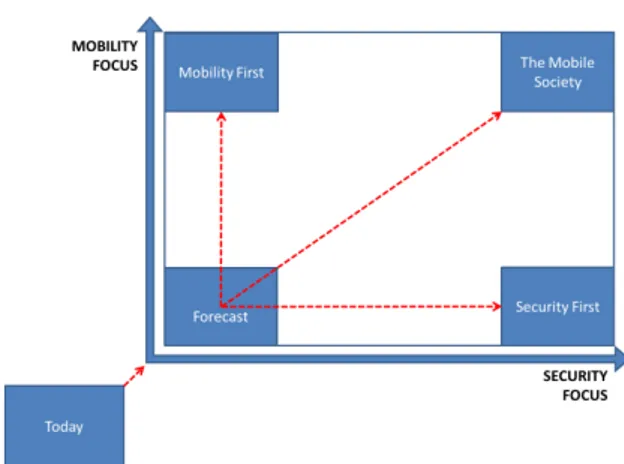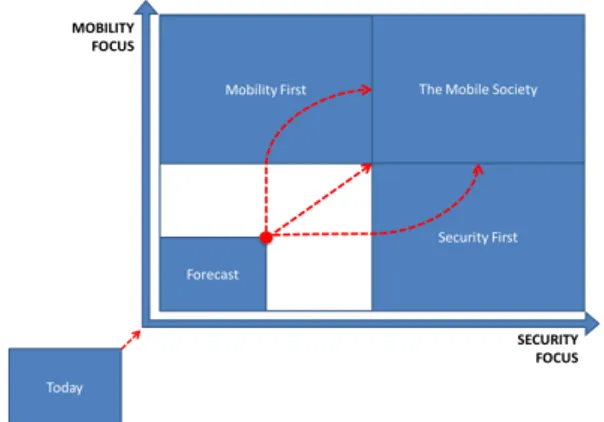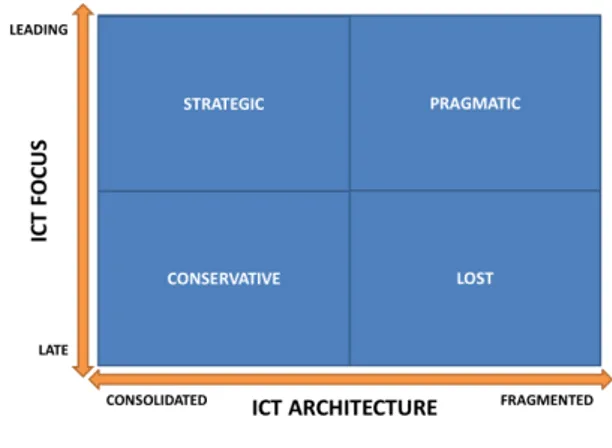THE FUTURE OF ENTERPRISE MOBILITY
Filip Lindwall and Sebastian Thesleff, Industrial Engineering and Management, Lund University, Faculty of Engineering, May, 2013
“Mobile computing is forcing the biggest change to the way people live since the automobile”. It has already conquered the consumer sphere. Now it is setting sight on the corporate counterpart and it is expected to be the next big productivity driver.
BACKGROUND
Data mobility has profoundly transformed our daily lives. As consumers, we are used to have instant access to information and we are able to do the majority of your IT tasks on-‐the-‐run. Yet, when we come to work, restrictive IT policies and old mobile devices many times limit us. A survey from 2011, among 4,100 full-‐time employees, showed that only 13% thought they had better IT hardware devices and software applications at work than at home.1
The ongoing consumer-‐driven mobility trend is expected to have far reaching consequences for the business sphere. For instance, the world’s largest business systems provider, SAP, says that we have entered a new wave of Enterprise Computing called consumer-‐driven Mobile Computing, which is the evolution of the previous steps; the mainframe, the client/server and the Internet. This new wave of enterprise computing is global and people-‐centric and it will be the next main productivity driver.2
Even though the IT departments are aware of the ongoing trend called the “Consumerization of IT”, the trend is moving too fast for most companies. In a study by IDC, a market analysis firm, in 2011, 48% of the IT departments rated their organization as “Late adopter – Last to Use” in terms of using social networking applications and consumer oriented devices for business purposes.3 The
employees are losing their patience and are not prepared to wait for the corporate IT to catch up. IT leaders recognize the reality: a recent survey of 4000 CIOs and senior IT-‐executives put mobile technologies as the second most important
1 (Harris, Ives, & Junglas, 2011) 2 (Fox, 2011)
3 (Gens, Levitas, & Segal, 2011)
technology trend, before both Cloud Computing and Enterprise Resource Applications (Business Intelligence being the most important).4
According to Gartner, a research firm, an enterprise will succeed or fail based on how it responds to social, cloud, mobility and big data.5 These forces are rewriting strategic playbooks across industries6 where the successful companies
of the future are already taking advantage of these dynamics to create innovative products and services, and reaching new customers in new contexts.7 End-‐user organizations and technology providers that are slow to move will be left far behind.8
A FUTURE STUDY OF ENTERPRISE
MOBILITY
The authors have analyzed the key trends and drivers of the phenomenon called Enterprise Mobility; created three distinct and plausible future scenarios to help understand the market development the coming three years; and created four Enterprise Response Profiles for the adoption strategy and key challenges for specific enterprises.
The authors define Enterprise Mobility as “the set of technology, applications, processes and policies that support the possibility to perform business activities anywhere at any time”.9
The Trend Analysis has been based on a multi-‐ source survey approach based on a custom framework that is a development of the PESTLED, and Porter’s Five Forces frameworks. The Future
4 (Gartner, September 13, 2012)
5 (Howard, Plummer, Genovese, Mann, & Willis, 2012) 6 (Lo, Wyble, & Hupfer, 2012)
7 (Howard, Plummer, Genovese, Mann, & Willis, 2012) 8 (Ibid)
Study is based on a mini-‐Delphi methodology with an expert panel of ten leading experts in three different fields: Convergence of Technology & Society, Enterprise ICT Development and Data Communication Development
MAIN TRENDS IN ENTERPRISE MOBILITY
The research has identified several distinct and important trends in Enterprise Mobility and related enterprise ICT. The ten most important trends are summarized below.First, within three years most office workers will be able to transition seamlessly between devices and over networks with access to their job data. The choice of the device will be a factor of screen size, input capabilities and other inherent characteristics of the device. Consumer facing companies, companies with less concern about data security and companies with a large mobile work force will lead the adoption.
Second, a large portion of the mobile work force will be digitalized within two to three years through an increase in the use of both mobile consumer and industrial devices. The average office worker will adopt several purposeful applications for handling specific tasks “on-‐the-‐ run”.
Third, the Consumerization of IT and demographics will be two key drivers for the development and adoption of Enterprise Mobility and other new enterprise ICT technology. Enterprises’ ability to adapt to the consumerization trend and offer intuitive solutions with high usability will be key competitive factors.
Fourth, there is a convergence of mobility, cloud computing, social and information which will create new business opportunities such as new business models, new applications and new revenue channels and we will increasingly see data-‐driven solutions and applications that in real time are combining behavior, sentiment, history and location in ingenious ways. It will take two to three years until this is widely spread in the consumer sphere and it will take even longer time for this to spread to enterprise applications.
Fifth, the IT-‐departments are moving towards a more strategic role where they are in charge of policies and interfaces between systems. Still, in three years’ time there will be a large spread between enterprises with a more strategic ICT outlook and others with a more traditional and conservative outlook.
Sixth, security issues are the largest constraint for the mobile development; yet, these issues will not halt the mobility trend; at most they can slow the adoption down. Still, security will be an important issue and many believe that identification solutions to limit access rights, better risk classed data, remote monitoring and other security solutions and policies will increasingly be used.
Seventh, the As-‐a-‐service delivery model will be the most important one within three years, at least for new installations. Particularly the consumption based spends and easy scaling are two big advantages for the as-‐a-‐service model. The SMEs without too much legacy structure will lead the adoption.
Eighth, there is a strong trend towards an increasing use of B.I./Analytics software and other applications for data driven decision-‐making and data sharing across corporate functions, systems, databases and applications. Still, it will take time until there is a widespread adoption and in three years’ time there are still security, behavioral and organizational hurdles to be dealt with.
Ninth, companies with established legacy systems will continue to have integrated in-‐house systems for their key processes. For not-‐as-‐key applications other delivery models such as managed services or enterprise app-‐stores will be an alternative where the IT-‐department provides the distribution, API and governance models. Still, three years’ time is too short to induce far-‐reaching changes to the business system delivery models.
Tenth, the coming three years will be pivotal in the development of the enterprise mobility and there are a lot of disruptive forces that could affect the outcome. There is a high probability of new disruptive market players and there is a convergence of the offers among the existing strategic vendors, which makes the market
disruptive. A key competitive ICT-‐strategy characteristic will be how well a company is able to cope with the changes.
MARKET DEVELOPMENT
In order to help prepare for the uncertain future and to provide sufficient time to act on the trends, the authors have made a future study of the development with a three years’ time horizon. First, a future forecast was constructed based on the more certain trends. Then, the forecast served as a starting point for the construction of the three distinct future scenarios that were developed from the more uncertain trends.
Above all, the research has shown that the future development will depend on the dynamics between the Mobility Focus and the Security Focus factors. The two different focuses become the two axes of a grid to plot the different scenarios, as seen in figure 1.
The Mobility Focus factors relates to how important mobility will be on the overall corporate agenda; the mobility investment decision; the spread and adoption of business-‐critical mobile enterprise applications and application distribution infrastructure; and how enterprises deal with the added complexity of introducing the mobile dimension.
Security factors relates to how important security and privacy issues will be on the corporate agenda; the demand for reliability and robustness; and how data management issues are treated the coming three years.
Figure 1 – The Market Development Framework.
The scenarios should not be seen as the three most probable outcomes. Instead, their purpose is to help recognize future developments as they happen and to understand the underlying dynamics and drivers behind the development. Therefore, they are constructed as extreme outcomes by making very large variations of the development of the axes, as seen in figure 2.
Figure 2 – Each Scenario as an Extreme Outcome.
THE FUTURE SCENARIOS
MOBILITY FIRST
The Mobility First Scenario depicts a future with strong focus towards mobility. Many early and successful “low hanging fruit” initiatives have created a mobile hype. The mobile initiatives are allowing more efficient processes and rationalizations, in areas such as approvals, submissions and workflows.
Employees are bringing in new consumer devices and applications; different corporate functions have different ICT agendas and adopt different solutions, push for specific applications or develop their own. This is creating a diverse spread of different mobile initiatives that aims to solve specific and independent problems. The policies, ICT strategy and security are struggling to keep up with the mobile development with a wide array of different systems, applications and infrastructure. Other problems are loose ICT governance, low security awareness, little user training and incomplete policy work as many enterprises are haunted by immature ICT management, underdeveloped security tools and outdated
policies, which all in all inhibits productivity. The complexity combined with the highly decentralized corporate ICT makes some wonder if we arrived at the “IT-‐department hell”.
SECURITY FIRST
The Security First scenario depicts a future where there is large security awareness, and an emphasis of managing data and information and using reliable and robust systems. Likely there has been some major security and/or privacy incident that has spurred the security demand. In this scenario there is less mobile hype. Uncontrolled end-‐points, non-‐approved applications and non-‐compliance to policies are seen as major security concerns and enterprises invest heavily in measures and policies to secure their systems. The enterprise mobility trend has slowed down and enterprises are looking for comprehensive, mature and secure solutions to address mobility and to protect their corporate data.
Data control and data management are seen as key factors, which promotes enterprises to work cross-‐functionally to negotiate new security level and risk class data. As data and information management issues are increasingly resolved, new possibilities for data sharing are appearing. Business Intelligence solutions, analytical software and Big Data Technology are very prominent technologies.
Finally, the security and data management focus makes employees feel constrained and monitored which inhibit innovation, creativity and productivity.
THE MOBILE SOCIETY
The Mobile Society scenario depicts a future with a high degree of mobile adoption, a high level of security and an advanced control and use of data. We are finally seeing the convergence of mobility, cloud computing, social and information which opens up new possibilities for new business models, new use of data, new processes, and new applications. Business Intelligence solutions and Big Data Technology are widely used and the ability to combine data in ingenious ways to create new
solutions, products and services is a key competitive factor for leading companies.
ICT is a core part of the corporate strategy and the IT department has taken a strategic advisor role and coordinates the ICT across functions. The mobile dimension is managed by a combination of softer and harder initiatives such as risk classed data, security policies, governance models, comprehensive MDM solutions, identification solutions and enterprise app-‐stores.
The consumers are demanding ubiquitous access to information and business. Omni-‐channel commerce is well established and all consumer facing and most B2B companies need to have a mobile channel presence. Employees are demanding flexibility and empowerment and they are bringing in new devices and demanding intuitive and purposeful applications that support them in their work. In short, we have arrived at “The Mobile Society”.
This study has shown that the long term trend is pointing towards The Mobile Society; yet, in three years’ time it is very possible that the development is still in one of the “transitory” stages, Mobility First or Security First.
Figure 3 – The Long Term Trend towards The Mobile Society
THE ENTERPRISE RESPONSE
Each enterprise has its own inherent characteristics, capabilities and history, therefore responds to the mobility trend differently. This means that each enterprise has a unique development path.
This research has shown that a particular enterprise’s response to the mobility trend depends on two factors.
First it depends on its Mobility Focus vs. Security Focus where each particular enterprise has to decide whether they want to enable mobility through a fragmented, case-‐by-‐case, ICT architecture approach or by a slower and a more consolidated ICT architecture approach. This resonates strongly with the market development model, which also can be used to categorize particular enterprise responses to mobility.
Figure 4 -‐ The Enterprise Response to Mobility.
Second, it depends on its ICT Focus where an enterprise either can have a reactive response, i.e. a “Late Response” or proactive response, i.e. a “Leading Response”.
Figure 5 – A ”Leading” or ”Late” ICT Approach.
By combining the enterprise ICT architecture approach and the enterprise ICT focus the study has showed that it is possible to divide enterprises into four distinct Enterprise Response Profiles. These profiles can be used to categorize or recognize customers.
Figure 6 -‐ The LTH Model.
THE ENTERPRISE RESPONSE PROFILES
LOST
The Lost enterprises are either too overwhelmed by the Consumerization of IT and is refraining from responsibility by giving the users a free rein to bring in BYOD and BYO applications with no/little supervision, governance models or support; or they are enterprises that are acting on independent mobile initiatives without strategy, decisiveness or coordination to make any major impact.
PRAGMATIC
The Pragmatic enterprises are realizing a wide array of different initiatives and are in the forefront of using new applications, channels and taking advantage of new business opportunities. Their focus is characterized by quick initiatives to stay ahead and they often appear to be the leaders in using mobility in their industry. Yet their rapid adoption often lack a uniform approach, which is creating a wide array of different databases, applications and interfaces with compatibility issues and solutions that are not integrated, leaving the employees to do the integrating manually between different systems.
CONSERVATIVE
The Conservative enterprises either see mobility as a threat and take a firm stance against BYOD and other user-‐induced mobile initiatives; or are deliberately slow to act in order to see where the
trend is going. These enterprises have a centralized IT-‐department with strict rules towards devices and applications and they promote an integrated approach, which emphasizes mature, reliable, robust and secure systems. This makes them slow on realizing potential gains from using mobility and the strict and centralized approach is inhibiting innovation and employee satisfaction.
STRATEGIC
The Strategic enterprises are taking a comprehensive and integrated approach to mobility and they are emphasizing reliability, data management and security while they still actively are employing a mobile strategy that is taking advantage of the new technology. These enterprises put the toughest requirements on new applications, integrate solutions and risk class data that open up new possibilities for the adoption of data-‐driven decision making solutions.
LEARNINGS
As seen, the enterprises are facing a very fast-‐ paced, uncertain, transformative and disruptive ICT future. Enterprise Mobility will be one of the main defining factors that will offer new opportunities and upset the status quo. How an enterprise responds to Enterprise Mobility and the convergence of other forces, such as cloud, information and social networks will to a large degree decide their future success or failure. To be successful in the future, one needs to start today. The first step for should be to learn to recognize the developments and the underlying drivers that were presented in the Future Study. Second, in order create an actionable plan forward, the enterprise needs to recognize its starting position and key challenges ahead. Here, the Enterprise Response Profiles can serve as a guide. Finally, the authors hope and believe that this article can help companies and other organization to create a sound starting point for a comprehensive, proactive and forward-‐looking ICT strategy.
BIBLIOGRAPHY
Fox, A. (2011). Mobility –The new wave of Enterprise Computing”. Sydney: SAP.
Gartner. (September 13, 2012). Gartner Press Release (Sept 2013): Business Intelligence, Mobile and Cloud Top the Technology Priority List for CIOs in Asia: Gartner Executive Programs Survey. http://www.gartner.com/newsroom/id/2159315 . Singapore, Singapore.
Gens, F., Levitas, D., & Segal, R. (2011). Consumerization of IT Study : Closing the “Consumerization Gap”. Framingham: IDC. Harris, J. G., Ives, B., & Junglas, I. (2011). The Genie Is Out of the Bottle: Managing the Infiltration of Consumer IT Into the Workforce. New York: Accenture.
Howard, C., Plummer, D. C., Genovese, Y., Mann, J., & Willis, D. A. (2012). The Nexus of Forces: Social, Mobile, Cloud and Information. Gartner.
Lindwall, F. & Thesleff, S. (2013). The Future of Enterprise Mobility. Lund: Lund University -‐ Faculty of Engineering.
Lo, J., Wyble, C., & Hupfer, S. (2012). Fast track to the future -‐ The 2012 IBM Tech Trends Report. IBM Center for Applied Insights.


